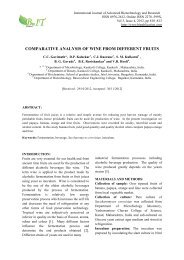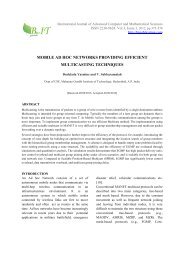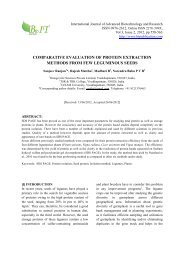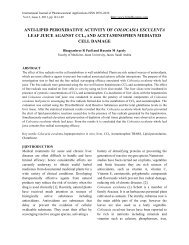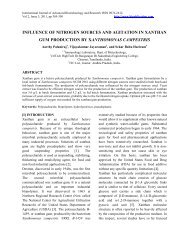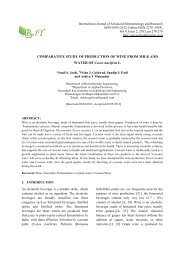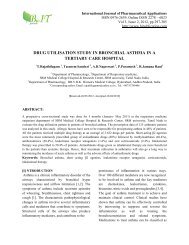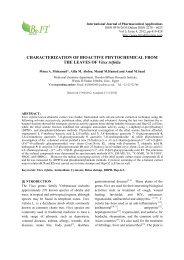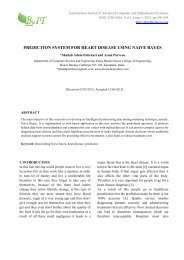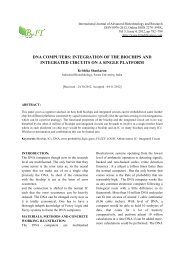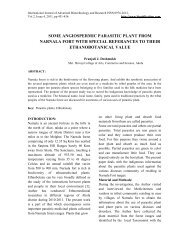effects of fluoride contents in ground water - BioIT international ...
effects of fluoride contents in ground water - BioIT international ...
effects of fluoride contents in ground water - BioIT international ...
Create successful ePaper yourself
Turn your PDF publications into a flip-book with our unique Google optimized e-Paper software.
EFFECTS OF FLUORIDE CONTENTS IN GROUND WATER: A REVIEW<br />
that too little (1.5mg/l)<br />
[3, 4]<br />
can affect bone and teeth structure.<br />
Among the <strong>water</strong> quality parameters, <strong>fluoride</strong> ion<br />
exhibits unique properties as its concentration <strong>in</strong><br />
optimum dose <strong>in</strong> dr<strong>in</strong>k<strong>in</strong>g <strong>water</strong> is advantageous<br />
to health and if the concentration exceeds the<br />
limit, this affects the health. [5] High <strong>fluoride</strong><br />
concentration <strong>in</strong> the <strong>ground</strong> <strong>water</strong> and surface<br />
<strong>water</strong> <strong>in</strong> many parts <strong>of</strong> the world is a cause <strong>of</strong><br />
great concern. The ma<strong>in</strong> source <strong>of</strong> <strong>fluoride</strong> <strong>in</strong><br />
<strong>ground</strong> <strong>water</strong> is <strong>fluoride</strong>-bear<strong>in</strong>g rocks such as<br />
fluorspar, fluorite, cryolite, fluorapatite and<br />
hydroxylapatite. [6] Also the content <strong>in</strong> <strong>ground</strong><br />
<strong>water</strong> is a function <strong>of</strong> many factors such as<br />
availability and solubility <strong>of</strong> <strong>fluoride</strong> m<strong>in</strong>erals,<br />
velocity <strong>of</strong> flow<strong>in</strong>g <strong>water</strong>, pH, temperature,<br />
concentrations <strong>of</strong> calcium and bicarbonate ions <strong>in</strong><br />
[7, 8]<br />
<strong>water</strong>.<br />
Though <strong>fluoride</strong> enters the body through <strong>water</strong>,<br />
food, <strong>in</strong>dustrial exposure, drugs, cosmetics, etc.,<br />
dr<strong>in</strong>k<strong>in</strong>g <strong>water</strong> is the major source (75%) <strong>of</strong> daily<br />
<strong>in</strong>take. [9] Due to its strong electronegativity,<br />
<strong>fluoride</strong> is attracted to positively charged calcium<br />
<strong>in</strong> teeth and bones. Major health problems caused<br />
by <strong>fluoride</strong> are dental fluorosis, teeth mottl<strong>in</strong>g,<br />
skeletal fluorosis and deformation <strong>of</strong> bones <strong>in</strong><br />
children as well as adults. [10] Excess <strong>fluoride</strong><br />
affects plants and animals also.<br />
Health Impacts <strong>of</strong> Fluoride:<br />
Fluoride is well recognized as an element <strong>of</strong><br />
public health concern. Fluoride is present<br />
universally <strong>in</strong> almost every <strong>water</strong> (higher<br />
concentrations are found <strong>in</strong> <strong>ground</strong><strong>water</strong>), earth<br />
crust, many m<strong>in</strong>erals, rocks etc. It is also present<br />
<strong>in</strong> most <strong>of</strong> everyday needs, viz. toothpastes,<br />
drugs, cosmetics, chew<strong>in</strong>g gums, mouthwashes<br />
and so on. [11, 12] Though a small amount <strong>of</strong> it is<br />
beneficial for human health for prevent<strong>in</strong>g dental<br />
carries, it is very harmful when present <strong>in</strong> excess<br />
<strong>of</strong> 1.0 ppm. World Health Organization (WHO)<br />
and IS: 10500 recommend that the <strong>fluoride</strong><br />
content <strong>in</strong> dr<strong>in</strong>k<strong>in</strong>g <strong>water</strong> should be <strong>in</strong> the range<br />
<strong>of</strong> 1.0 to1.5 ppm.<br />
Intake <strong>of</strong> more <strong>fluoride</strong>, results <strong>in</strong><br />
multidimensional health manifestations, the most<br />
[13, 14]<br />
common be<strong>in</strong>g dental and skeletal fluorosis.<br />
Higher concentration <strong>of</strong> <strong>fluoride</strong> also causes<br />
respiratory failure, fall <strong>of</strong> blood pressure and<br />
general paralysis. Loss <strong>of</strong> weight, anorexia,<br />
anemia, wast<strong>in</strong>g and cochexia are among the<br />
common f<strong>in</strong>d<strong>in</strong>gs <strong>in</strong> chronic <strong>fluoride</strong> poison<strong>in</strong>g.<br />
Cont<strong>in</strong>uous <strong>in</strong>gestion <strong>of</strong> nonfatal dose <strong>of</strong><br />
<strong>fluoride</strong>s causes permanent <strong>in</strong>hibition <strong>of</strong> growth.<br />
Fluoride ions <strong>in</strong>hibit a variety <strong>of</strong> enzymes <strong>of</strong>ten<br />
by form<strong>in</strong>g complexes with magnesium ions and<br />
other metal ions. [15-17]<br />
In India, there has been an <strong>in</strong>crease <strong>in</strong> <strong>in</strong>cidence<br />
<strong>of</strong> dental and skeletal fluorosis with about 62<br />
million people at risk [18] due to high <strong>fluoride</strong><br />
concentration <strong>in</strong> dr<strong>in</strong>k<strong>in</strong>g <strong>water</strong>. Dental fluorosis<br />
is endemic <strong>in</strong> 14 states and 150,000 villages <strong>in</strong><br />
India with the problem most pronounced <strong>in</strong> the<br />
states <strong>of</strong> Andhra Pradesh, Bihar, Gujarat, Madhya<br />
Pradesh, Punjab, Rajasthan, Tamil Nadu and<br />
Uttar Pradesh. [19]<br />
Prevalence <strong>of</strong> Fluorosis:<br />
India is among the 23 nations where<strong>in</strong> a large<br />
population suffers from dental and skeletal<br />
Fluorosis due to high F– concentration <strong>in</strong><br />
<strong>ground</strong><strong>water</strong>. [20-22] India has acute public-health<br />
problems <strong>in</strong>duced by utilization <strong>of</strong> <strong>ground</strong><strong>water</strong><br />
as a source <strong>of</strong> dr<strong>in</strong>k<strong>in</strong>g <strong>water</strong>. The health<br />
problems aris<strong>in</strong>g as a result <strong>of</strong> <strong>fluoride</strong> (F)<br />
contam<strong>in</strong>ation are far more widespread <strong>in</strong> India.<br />
Fluorosis was first detected <strong>in</strong> India, among cattle<br />
and humans <strong>in</strong> Andhra Pradesh. [23] In India,<br />
approximately 60–65 million people dr<strong>in</strong>k<br />
<strong>fluoride</strong> contam<strong>in</strong>ated <strong>ground</strong><strong>water</strong>, and the<br />
number affected by fluorosis is estimated at 2.5–6<br />
million, predom<strong>in</strong>ately children. [24, 25] In India,<br />
the excessive presence <strong>of</strong> <strong>fluoride</strong>s <strong>in</strong><br />
<strong>ground</strong><strong>water</strong> is present <strong>in</strong> nearly 177 districts<br />
cover<strong>in</strong>g 19 states. It appears that high-well<br />
<strong>fluoride</strong> may exist <strong>in</strong> many more districts. [26] The<br />
prom<strong>in</strong>ent states, which are severely affected, are<br />
Andhra Pradesh, Rajasthan, Gujarat, Uttar<br />
Ibrahim M, et al. 129



